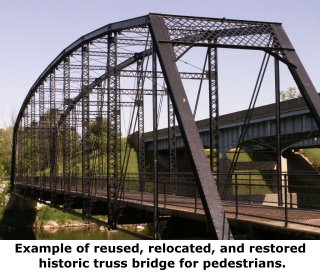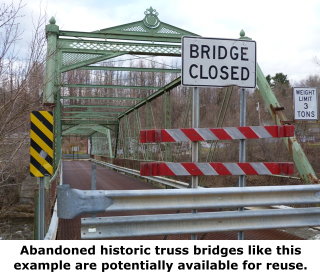Bridge Reuse & Restoration: Need A Historic Truss Bridge?
Bach Steel can find, restore, and relocate one for you!
 Do you need a bridge? Instead of a boring, uninspiring modern bridge, have you considered reusing and restoring a historic metal truss bridge? This is a perfect option for pedestrian or light vehicular bridges, making them outstanding candidates for trails, bike paths, parks, residential developments, golf courses, and even low volume public roads.
Do you need a bridge? Instead of a boring, uninspiring modern bridge, have you considered reusing and restoring a historic metal truss bridge? This is a perfect option for pedestrian or light vehicular bridges, making them outstanding candidates for trails, bike paths, parks, residential developments, golf courses, and even low volume public roads.
There are many beautiful historic truss bridges that are available across the country for relocation and reuse as an alternative to typical modern bridges. Most dating to the late 1800s and early 1900s, these bridges look a lot classier than typical modern bridges and make functional and eye-catching landmarks. They are usually cost effective to restore and reuse, and in many cases cost can be competitive with that of a typical modern bridge. Bridges that are available for relocation and reuse can be found across the country and are either abandoned, in storage, or otherwise slated for demolition. Bach Steel would love to help find new homes for these bridges.

Bach Steel can help you find one or more historic bridges that fit the needs of your crossing. Once you have identified a bridge that meets your requirements and interests, we can then acquire the bridge from its former owner, restore the bridge to like-new condition, and erect it on-site at your location. If needed, Bach Steel has connections with engineering firms who have experience working with these types of bridges and can provide engineering services for these projects. In addition to the iron and steel restoration and erection work that we provide, we also have the ability to provide the additional work needed to bring the bridge into service. These include blast cleaning and painting of the bridge, building abutments, deck installation, and additional railings. Paint, deck, and railing are all variables that can be defined by the client, or we can recommend options based on the intended reuse of the bridge. Available options and costs for deck, railing, and abutments of a historic bridge are similar to those available for a modern bridge. However, with railing, Bach Steel also has the ability to replicate (or adapt to meet modern standards) historic riveted railing types if desired.
Depending on variables including the particular bridge you are using, as well the existing funding sources you have, there may in some cases be additional funds available as a result of choosing to preserve the historic bridge. Bridges offered by state Departments of Transportation under a law called Section 4(f) may have funds for preserving the bridge available that are up to the estimated cost of demolition of the available bridge. This money can be helpful in underwriting some of the preservation project cost, but should not be expected to cover the entire cost. Alternatively, some bridges may not have this type of financial assistance available. However, do not let this discourage you from considering bridges without money attached. Bach Steel has seen situations where the bridge being offered has a lot of deterioration and is costly to restore, while a bridge that does not have funding assistance available is in very good condition and requires less restoration work. In these circumstances, the bridge with less deterioration might be less expensive in out-of-pocket costs.
 The work that we do to restore these bridges maintains the historic materials, design, and appearance of the bridge. At the same time, the completed product that will appear in your park will be restored to a like-new condition. A 100 year old bridge can readily be made ready for another century of service in a park or on a trail! Also note that depending on your needs, we may be able to make slight adjustments to the length and/or width of available bridges to fit the exact needs of your park’s crossing. We can do this work with a high level of quality, but also cost-effectively. It is what we specialize in and we enjoy doing it!
The work that we do to restore these bridges maintains the historic materials, design, and appearance of the bridge. At the same time, the completed product that will appear in your park will be restored to a like-new condition. A 100 year old bridge can readily be made ready for another century of service in a park or on a trail! Also note that depending on your needs, we may be able to make slight adjustments to the length and/or width of available bridges to fit the exact needs of your park’s crossing. We can do this work with a high level of quality, but also cost-effectively. It is what we specialize in and we enjoy doing it!
 Bach Steel has experience with “in-kind” restoration where the goal is to return a bridge to a like-new condition including appearance, design, and condition, while also striving to maintain as much of the original material as possible. This is the type of work we prefer to do, and this type of restoration is in keeping with the Secretary of the Interior’s Standards for Rehabilitation which broadly outline best practices for historic preservation projects.
Bach Steel has experience with “in-kind” restoration where the goal is to return a bridge to a like-new condition including appearance, design, and condition, while also striving to maintain as much of the original material as possible. This is the type of work we prefer to do, and this type of restoration is in keeping with the Secretary of the Interior’s Standards for Rehabilitation which broadly outline best practices for historic preservation projects.
Central to in-kind restoration is the use of riveting. While many fabricators and engineers have dismissed riveting as a “lost art” that can no longer be performed by anyone today, at Bach Steel, riveting is a standard service that we have perfected through experience. We can drive rivets both efficiently and with the same quality of craftsmanship as the rivets that have safely held these historic truss bridges together often for well over a century. As such, we do not charge a premium for the service of riveting, allowing us to perform riveting as a cost that is competitive with using modern bolts as bridge fasteners.
For details about riveting, view our page: Riveting: Not a Lost Art, a Bach Steel Specialty
 Numerous other restoration techniques are used and perfected by Bach Steel such as pad welding for section loss and pneumatic pack rust removal. Additionally, Bach Steel prides itself in being able to exactly replicate portions of historic metal truss bridges, no matter how unusual the design details. The members of historic metal truss bridges often suffer from severe deterioration in portions of the member, while being in good condition in other locations. Rather than replace such members in their entirety, Bach Steel can remove the deteriorated section and weld an exact replica of that section back onto the truss member.
Numerous other restoration techniques are used and perfected by Bach Steel such as pad welding for section loss and pneumatic pack rust removal. Additionally, Bach Steel prides itself in being able to exactly replicate portions of historic metal truss bridges, no matter how unusual the design details. The members of historic metal truss bridges often suffer from severe deterioration in portions of the member, while being in good condition in other locations. Rather than replace such members in their entirety, Bach Steel can remove the deteriorated section and weld an exact replica of that section back onto the truss member.

Some, but not all, potentially available historic bridges can be found online using the links available from this page at the Historic Bridge Foundation. Additionally, in Morrow County, Ohio there are about a dozen truss bridges that are to be replaced in the 2015-2016 time frame and once dismantled, they would be put in storage and be immediately available for reuse. Most of the bridges are small, from 35-70 feet and would be relatively easy to restore. A list that identifies the Morrow County bridges to be made available can be found here. Also, additional bridges beyond those listed in the above two locations may be available. Please contact Bach Steel to discuss your project and we will provide a complimentary search for potential bridges. Finally, do not be afraid of rust. Available bridges that have rust may actually be less costly to restore than bridges with old paint, since the later may require the cost of paint removal. Also, many of the bridges are made of wrought iron, which behaves somewhat like weathering steel, and develops surface rust only.
Bach Steel is excited for an opportunity to be a part of any historic truss bridge preservation project across the country, and we can provide insight from project conception to project completion. In addition to our ability to restore historic metal truss bridges, we are always excited to lend our knowledge and insight during the project planning process. Our hands on experience with these bridges enables us to assess the condition of the bridge, help develop an appropriate scope of work for restoration, present different options for items such as deck and paint systems, and to help generate an accurate project cost estimate. Bach Steel would be happy to work with your project’s existing engineer, or if you are in need of an engineer for your project, we have engineering firms we have worked with and can recommend for you.
 Bach Steel has experience restoring bridges in place over rivers, but also has extensive experience with carefully removing bridges from a river, non-destructively dismantling them into parts, and restoring them in a shop setting. The later method, particularly with pin-connected truss bridges, is usually more cost-effective by avoiding special procedures that are required when working over a river, and also allows for a more thorough cleaning and restoration.
Bach Steel has experience restoring bridges in place over rivers, but also has extensive experience with carefully removing bridges from a river, non-destructively dismantling them into parts, and restoring them in a shop setting. The later method, particularly with pin-connected truss bridges, is usually more cost-effective by avoiding special procedures that are required when working over a river, and also allows for a more thorough cleaning and restoration.
